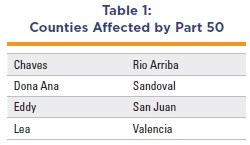By Thomas Leleck, Managing Director, Arktos Environmental
NMED Ozone Precursor Rule
Background
On July 26th 2022, the New Mexico Environment Department (NMED) published the 20.5.50 Oil & Gas Sector – Ozone Precursor Pollutants (Part 50) in Issue 14 of the NM Register. The goal of this regulation according to the NMED is to, “establish emissions standards for volatile organic compounds (VOC) and nitrogen oxides (NOx) for oil and gas sources located in areas of the State within the Environmental Improvement Board’s jurisdiction where ozone concentrations are exceeding 95% of the national ambient air quality standard” (NMED, 2020). The standards for equipment leaks in section 20.2.50.116 are more stringent in terms of the scope of process streams and total monitoring events than the current federal leak detection and repair (LDAR) requirements. Part 50 becomes effective on August 5th, 2022, so it is important to understand the LDAR implications at applicable facilities.
Part 50 applies to the following counties who exceed 95% of the 70 parts per billion (ppb) national ambient air quality standard established in 2015:

20.2.50.111 – 112 – Applicability & General Provisions
Applicability
The proposed rule applies to crude oil, natural gas production, and processing equipment associated with operations that extract, collect, separate, dehydrate, store, process, transport, transmit, or handle hydrocarbon liquid or produced water in the counties specified in Table 1. Oil transmission pipelines, oil refineries, natural gas transmission pipelines (not including transmission compressor stations, and saltwater disposal facilities). The owner or operator must calculate the Potential to Emit (PTE) of a source and have the PTE calculation with hydrocarbons, except for components where process streams consist solely of glycol, amine, produced water, or methanol.
Monitoring Requirements – Natural Gas Processing Plants
There are two sets of monitoring requirements for equipment leaks including audible, visual, and olfactory (AVO) requirements and either U.S. EPA method 21 (M21) or optical gas imaging (OGI). Owners or operators are required to conduct AVO inspections on all applicable components (thief hatches, closed vent systems, pumps, compressors, pressure relief devices, open-ended valves or lines, valves, flanges, connectors, piping, and associated equipment) according to the frequencies laid out in Table 2. There is exception for facilities with an average daily production rate that qualifies for a monthly AVO monitoring frequency where if that facility is within 1,000 feet of an occupied area, that facility must conduct AVO inspections at least weekly.
The second set of monitoring requirements allows owners and operators to choose either M21 or OGI to comply with Part 50 monitoring requirements. For both M21 and OGI inspections, the frequency at which applicable components must be monitored is determined by the facilities potential to emit (PTE) VOC’s in tons per year (tpy) as shown in Table 3. Additionally, prior to conducting a monitoring event, the date and time stamp of the event must be recorded.

Leak Procedures for RM 21
When leaks are identified using M21, there are several requirements the M21 instrument must meet. The M21 instrument must be calibrated at the beginning of each monitoring day according to the procedures described by the manufacturer and those found in 40 CFR 60 Appendix A-7. With M21, the leak definition is 500 ppm or greater of hydrocarbons when measured on any applicable equipment. The exception to this is any equipment that is venting as part of normal operation like pneumatic device actuation or crank case ventilation.
Leak Procedures for OGI
When leaks are identified using OGI as the monitoring method, the OGI instrument must comply with the specifications, daily instrument checks, and leak survey requirements found in 40 CFR 60.18(i)(1)-(3). With OGI, a leak occurs if any emissions are imaged by the OGI instrument. The exception is the same as with M21 regarding any equipment that is venting as part of normal operation.
Difficult, Unsafe, and Inaccessible to Monitor Components
Additional monitoring exceptions involve unsafe, difficult, or inaccessible to monitor components. Components are considered difficult to monitor if they cannot be monitored without elevating the monitoring personnel 2 meters or more above a supported surface. Components are considered unsafe to monitor if they expose monitoring personnel to immediate danger as a consequence of completing monitoring. Components are considered inaccessible to monitor if they are buried, insulated, or obstructed by equipment or piping that prevents monitoring personnel from accessing them. These components are not required to be inspected until it becomes feasible to do so.
Repair Requirements
The repair requirements for leaks identified by AVO, M21, and OGI are succinct. A visible tag must be placed on a leaking component and remain there until the component is repaired. For all leaks, a repair must be made within 30 days of discovery, regardless of the methodology. Equipment must be re-monitored within 15 days of repair to demonstrate a repair is successful. If a repair is not feasible within 30 days of discovery without a process unit shutdown or due to shortage of parts, the leak may be designated ‘Repair Delayed’. Leaks designated as ‘Repair Delayed’ that need a process unit shutdown must be repaired before the end of the next process unit shutdown or within 2 years, whichever is earlier and those delayed due to shortage of parts must be repaired within 15 days of the resolution of a parts shortage.
ABOUT THE AUTHOR
Tom Leleck II is the Co-Founder and Managing Director of Eastern Operations for Arktos Environmental LLC in Pittsburgh, PA. He graduated with a Bachelor of Science in Petroleum and Natural Gas Engineering from Pennsylvania State University. He has 7+ years of experience working in LDAR with a focus in providing OGI services and specializing in the development and implementation of AWP programs. In less than 2 years, he has helped Arktos grow into over 10 states across the U.S. in the oil & gas, petrochemical, and ethanol industries.




